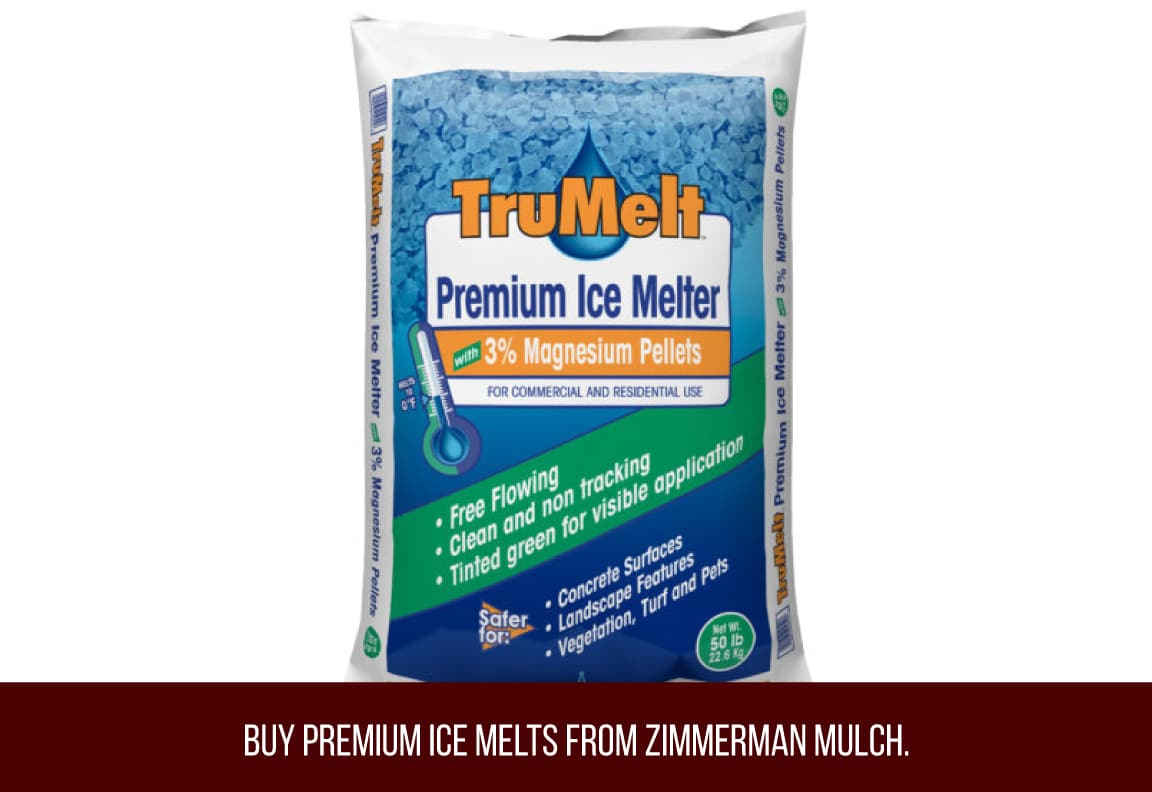Everything You Need To Know About Ice Melt (and how to choose the best kind)
We've all experienced the hazards of winter: snowstorms, power outages, bad roads, and sidewalks covered in a sheet of ice.
At Zimmerman Mulch, we understand you want to keep your family, guests, clients, and employees safe this winter.
This means you will be investing hours of hard work into keeping your parking lots and sidewalks free of ice and safe for walking and driving.
You want the best possible return from all this effort. The last thing that you want is to see it go to waste!
Since many different ice melt products are available, knowing which product or combination to use for a specific application can be confusing.
That's why we have compiled this list of different types of ice melts with the pros and cons of each. After reading this article, we hope that you will better understand the following:
- Exactly what ice melt is, how it works, and the instances when using it causes harm rather than good.
- Key points to consider when choosing an ice melt once you know that ice melt is what you need.
- The pros and cons of 6 different types of ice melt.
Let's get started!
What is Ice Melt?
Ice melt is a substance applied to surfaces to melt snow or ice. You can use it before snow and ice to prevent buildup or on top of existing snow and ice to break down the snow and ice into slush.
How does ice melt work?
The chemicals mix with water and lower the water's melting point. This prevents the water from freezing at higher temperatures, keeping your driveways and sidewalks clear for extended periods.
Applying ice melt to ice or snow dissolves into unfrozen water to form a brine solution. This brine works its way down through the ice, melting and breaking it up.
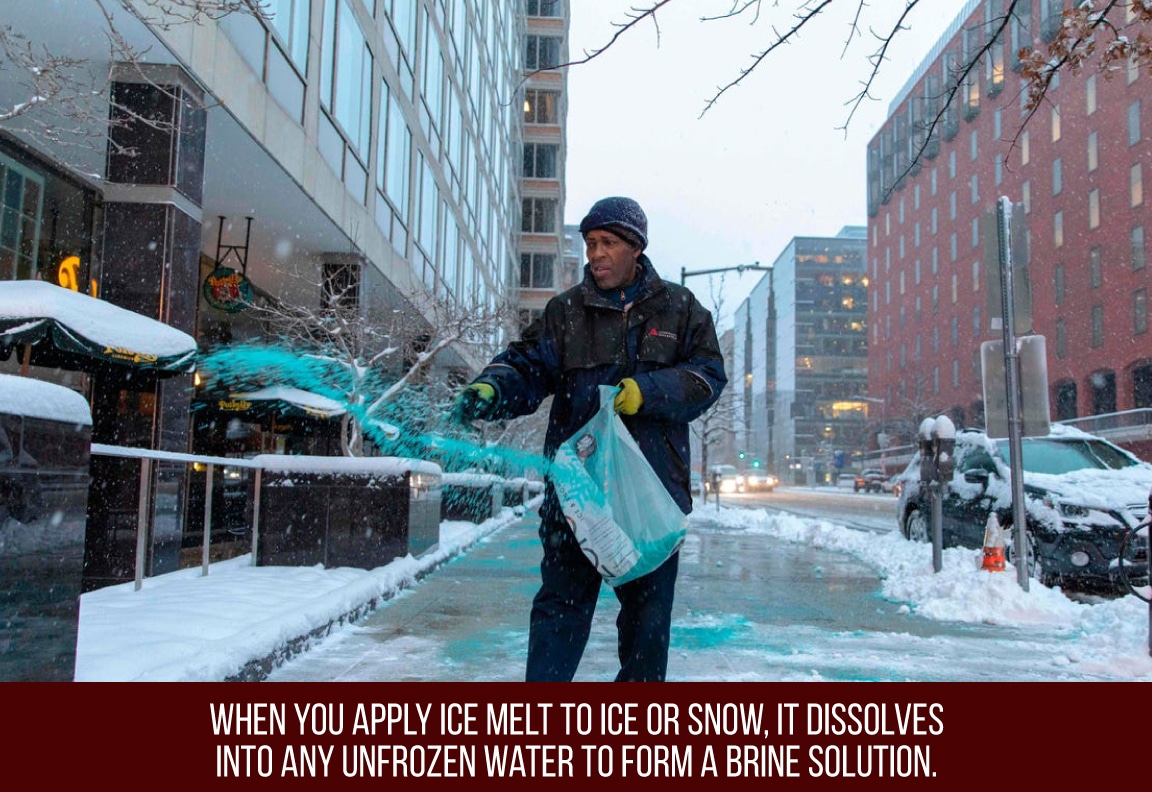
It also breaks the bond between the ice and the ground surface, allowing for easier scrape-off.
Is Ice Melt Bad?
Yes, it does have some downsides. It can negatively affect your hardscaping, vehicle, environment, and even your family and pets. You need to be careful and responsible when using ice melt.
For your hardscaping
Ice alone can be bad for your patio, driveway, or sidewalk. During cold weather, water that has run down into cracks in your hardscaping freezes. Since water expands when it freezes, the cracks will also grow, leading to a deterioration of your sidewalk or patio.
Although salt water takes longer to freeze, it expands 40% more than regular water when it does! Most ice melts contain salt, so ice melt can be very hard on sidewalks and patios if the temperature falls below the ice melt's freezing point.
But we don't want to scare you! Ice melt won't wreck your sidewalk in one winter and can be used safely. If you are interested, here's some info on maintaining your hardscapes to last longer.
For your car
Salt residue from ice melt on the road can cause the paint on your car to corrode, leading to rust. This can cause significant damage to critical parts of your vehicle, such as the brake lines.
An excellent way to help prevent this is to have your car undercoated with oil in the fall before the snow flies and the roads require winter treatment.
Wondering what else you should do to your car this fall? Here are 27 things you must do to prepare your vehicle for winter.
For your family and pets
Ice melt can be toxic or irritating to your children or your pets. Some ice melts might cause chemical burns on your dog's or cat's paws, or they might be harmful to your toddler if they are swallowed.
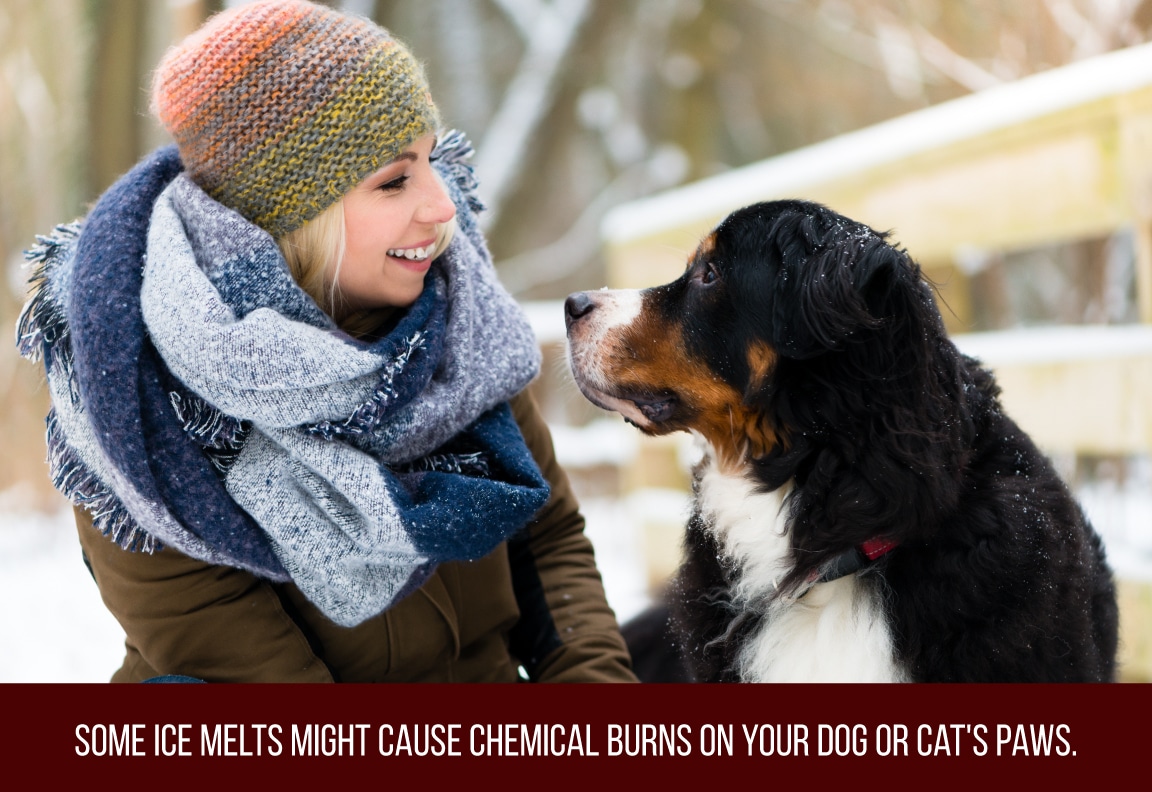
Here's what to do if your child swallows ice melt or some other toxic substance.
Even common rock salt, which would appear to be safe, can be harmful. Prolonged exposure to rock salt can irritate your pet's paws, and if your pet overeats it, it can cause gastrointestinal issues.
Always be familiar with the ingredients in your ice melt, and try not to over-apply it.
For the environment
The USA spreads an average of 24 million tons of salt on the roads annually.
That's a lot of salt. And the environmental effects of it need to be considered.
Chemicals from deicing products, such as road salt, can enter runoff and the soil and groundwater. There, they can have negative impacts on the ecosystem. Chloride, a salt component in most ice melt, can be especially harmful.
Also, since salt and plants don't mix well, an over-application of ice melt on your sidewalks can harm your flower beds.
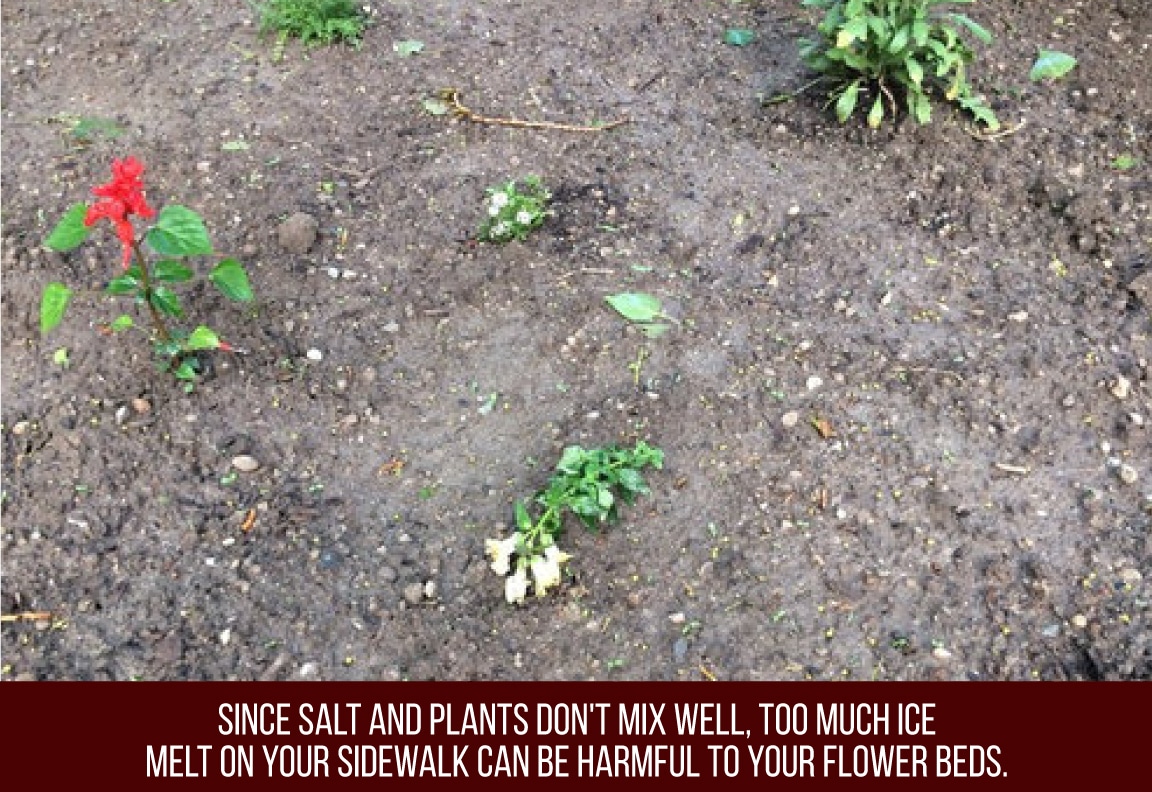
Fun fact: Ancient conquerors such as the Romans would sprinkle salt on the fields in conquered lands, making them infertile and useless.
Why are there different types of ice melt?
Different types of ice melt vary in performance according to the conditions. They will all do the job but are suitable for different situations.
For example, there is solid ice melt (such as rock salt), and liquid ice melt is already in the brine form.
- Solid ice melt is often applied on top of existing snow and ice. Absorbing moisture forms a brine and works its way downwards, melting the ice and loosening the bonds between the ice and the ground surface. Since solid ice melt needs moisture to work, its performance may disappoint in frigid temperatures.
Solid ice melt can be applied by hand or with a sand or salt spreader.
- Liquid ice melt is often applied before the weather to prevent snow or ice buildup. Since it is already in the brine form, it works at colder temperatures than its solid counterpart.
Liquid ice melt can be applied with a hand sprayer or, in commercial settings, a tanker truck.
For a second example, some deicers are exothermic, and some are endothermic:
- Since Exothermic deicers release heat and melt ice very quickly, they work great at frigid temperatures. Magnesium chloride and Calcium chloride are both exothermic.
- Endothermic deicers need to draw some heat from their surroundings to dissolve. They are usually slower than exothermic deicers, especially in icy conditions when there is little moisture to draw in. Rock salt, or Sodium chloride, is endothermic.
There are also different types of chemicals used in ice melt that vary in price and performance in different situations. We will look at these different types of chemicals and how they compare later in this article.
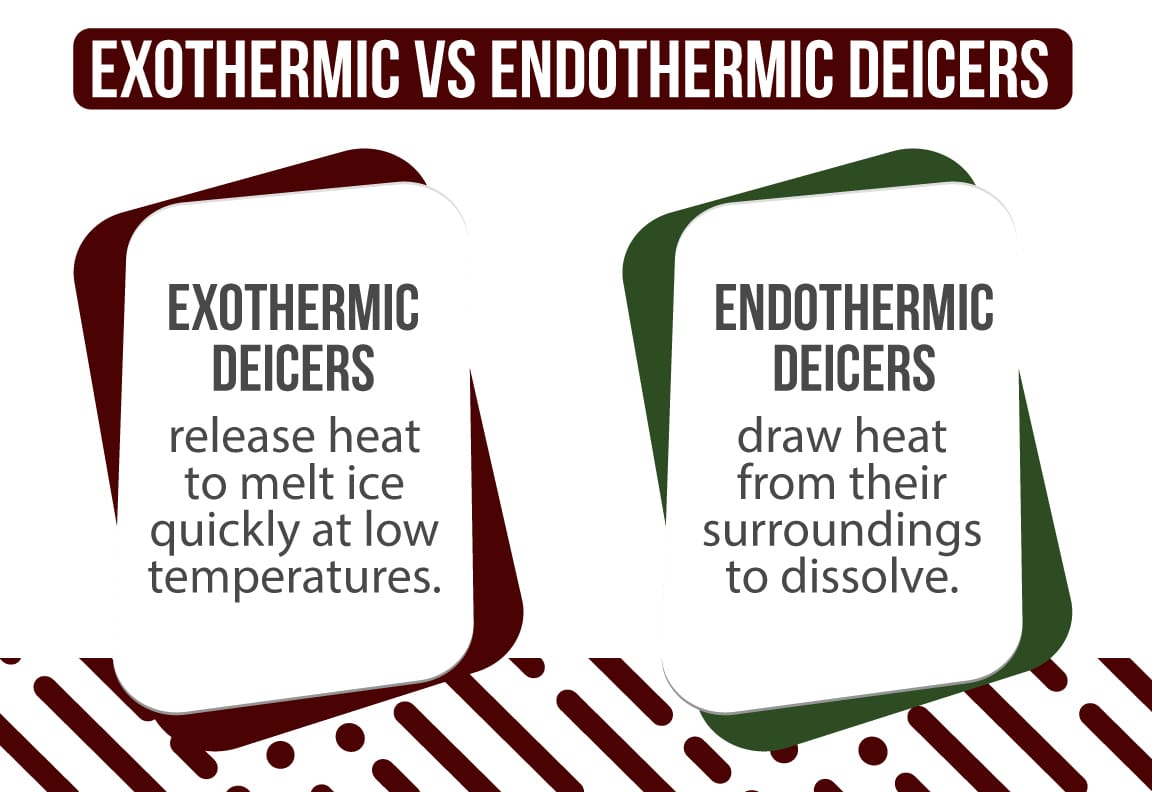
4 Things to think about
when choosing an ice melt
When choosing your ice melt, it is vital to remember the conditions in which you will be using it. This will help you make the best selection.
You should consider four factors when choosing between the different products.
Lowest melting point
The lowest melting point is the lowest temperature at which the ice melt will be effective.
Using ice melt at temperatures lower than its lowest working temperature will not produce results. Some ice melt is effective at temperatures as low as -25 degrees F. Some will only work down to 25 degrees F.
In freezing temperatures, exothermic ice melt, which releases its heat, will be more effective because it produces moisture, allowing the brine to form and penetrate the ice.
Endothermic ice melt will work better in moderately cold temperatures such as 20 degrees F and above because it needs to draw a certain amount of heat energy from its surroundings to dissolve.
Residual Action
Some deicers will work for more extended periods than others.
An ice melt with more extended residual action will require less frequent application.
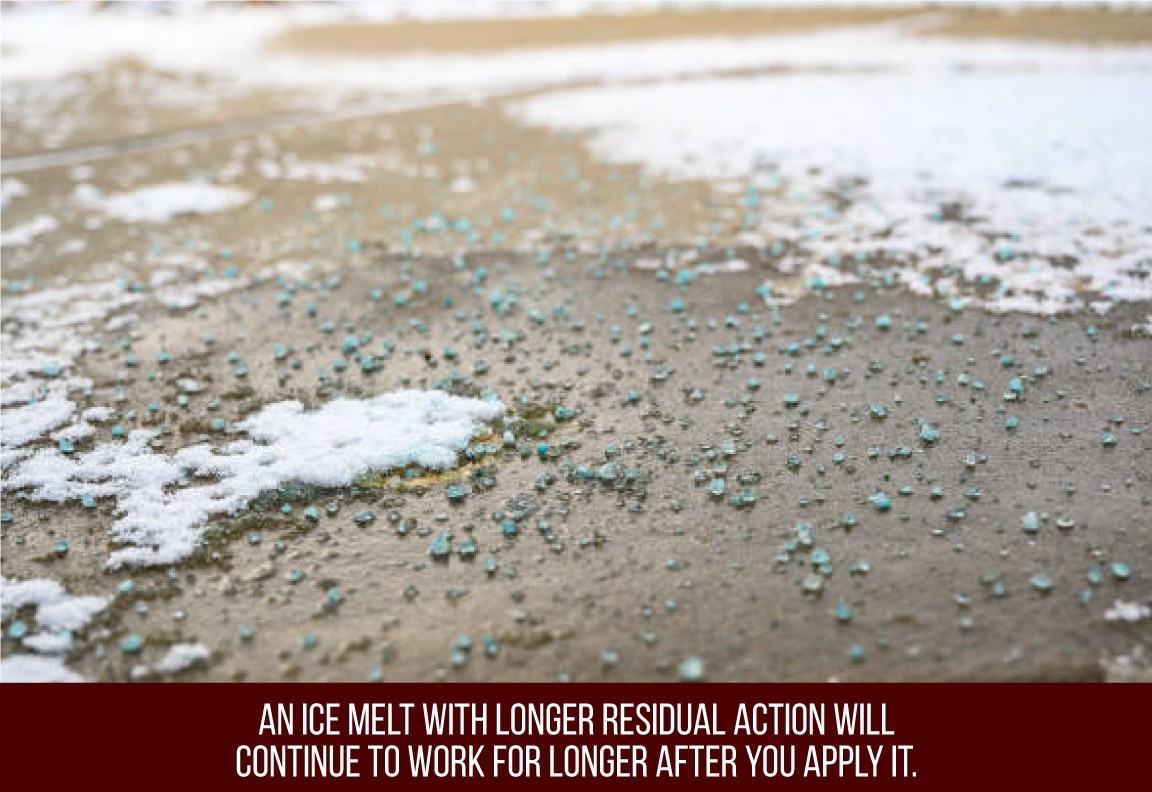
Products with more prolonged residual action usually present a higher upfront cost, but they are more economical in the long run since you use less of them.
Liquid ice melts generally provide greater residual action than solid ice melts because they remain in the brine state longer than their solid counterparts.
Environmental Factors
As stated before, the chemicals in your ice melt will affect the surrounding areas.
Different products have varying effects on the plants, animals, and waterways in the environment and on artificial substances such as concrete and grates.
Consider the surroundings carefully when you choose your product and again later when you apply it.
Here's an article explaining de-icing chemicals' effects on soil, vegetation, groundwater, etc.
Price
Of course, there is always the matter of price. Pricing will vary depending on the manufacturer and ingredients in the ice melt. Some compounds are more expensive than others.
Next, this article will look at six types of ice melt in order of price.
Let's take a look!
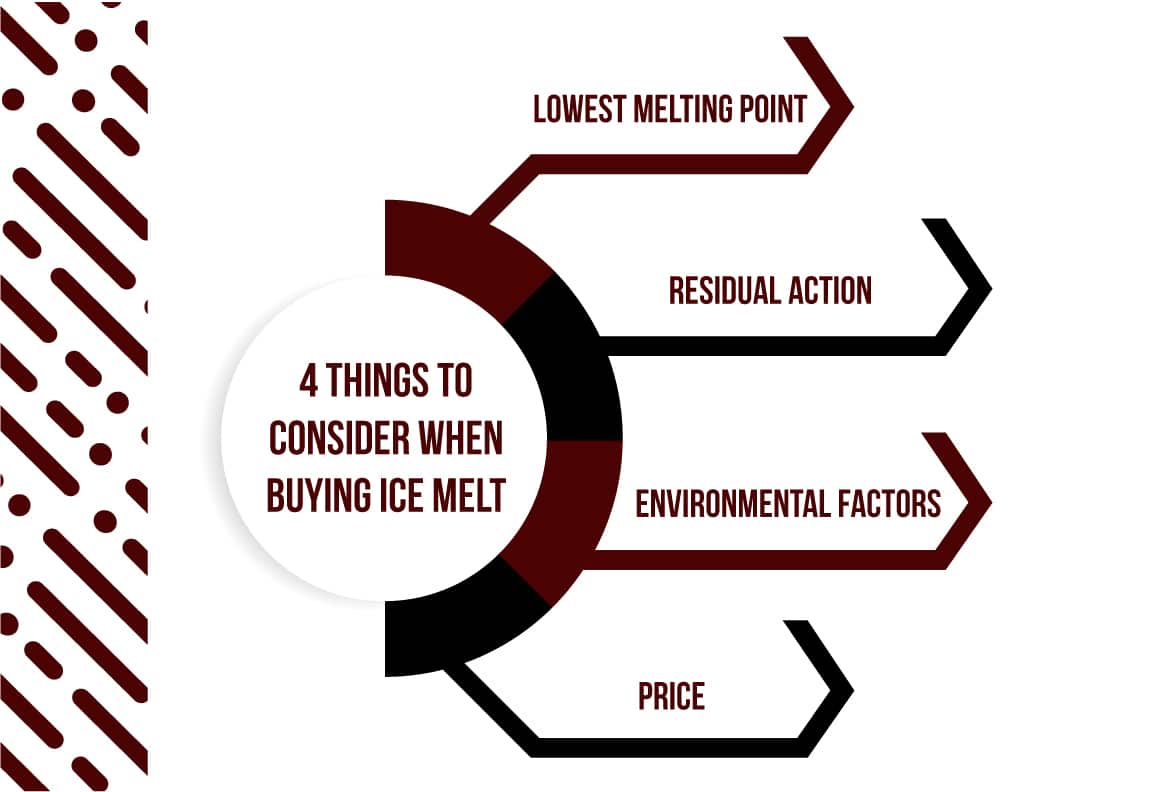
Pros and cons of 6 types of ice melt
Here is a list of the six most common types of ice melt in order of price, from most expensive to least expensive:
- Sodium acetate
- Urea
- Calcium chloride
- Magnesium chloride
- Blends
- Sodium chloride (rock salt)
Understanding the essential features of each type of ice melt will help you know which is the best for you.
Let's look at the main features of each of these six types in the order that they are listed.
Remember that the lowest melting point and price may vary for different manufacturers.
Sodium Acetate
Lowest melting point: 0 degrees F
The average price for a 50 lb bag: $100.00
Pros
- Sodium acetate is not salt-based. Since it lacks chloride, it is more environmentally friendly and does not cause corrosion of metals.
- Sodium acetate has a long residual effect.
- The FAA has approved sodium acetate for use on commercial airport runways.
Cons
- Sodium acetate is the most expensive type of ice melt.
Urea
Lowest melting point: 25 degrees F
The average price for a 50 lb bag: $55.00
Pros
- Since urea, like Sodium Acetate, is not salt-based and does not contain chlorides, it is less corrosive to metals. Like Sodium acetate, it has been a preferred ice melt for airports.
- Urea, containing nitrogen, is safer for plants than many ice melts; its primary use is fertilizer. However, since applying too much urea can burn plants, use it in moderation.
Cons
- Urea is more expensive than most other deicing products.
- Urea is not effective at temperatures below 25 degrees F.
- Urea can be very harmful if misused or used in excess.
- For these reasons, urea is seldom used as an ice melt anymore.
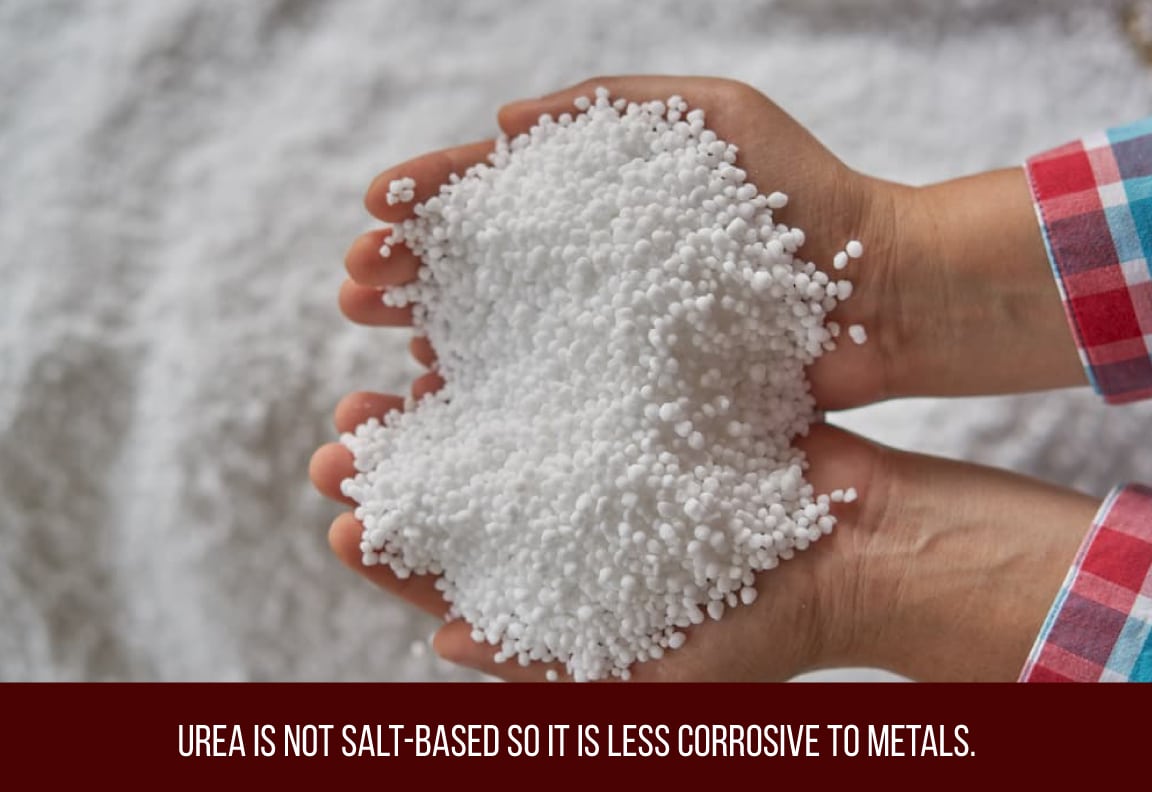
Calcium Chloride
Lowest melting point: -25 degrees F
The average price for a 50 lb bag: $40.00
Pros
- Calcium chloride is the most effective ice melt at lower temperatures.
- Since calcium chloride is exothermic and hygroscopic (water-attracting), it's one of the fastest-acting ice melts.
- Calcium chloride is one of the most widely used ice melts after rock salt.
Cons
- Calcium chloride is more expensive than common ice melts such as rock salt.
- Calcium chloride is harsh and corrosive on most surfaces. It's irritating to the skin and bad for the environment. It's not a good choice for places with pets or children.
If you need an ice melt today, Zimmerman Mulch carries quality calcium chloride pellets that work great in hand spreaders.
Magnesium Chloride
Lowest melting point: -15 degrees F
The average price for a 50 lb bag: $35.00
Pros
- Since Magnesium Chloride is exothermic, it works well in colder temperatures.
- Since Magnesium Chloride is also hygroscopic (water-attracting), the action is fast.
- Magnesium Chloride is less corrosive and slightly more plant-friendly than calcium chloride or sodium chloride.
- Magnesium Chloride is more eco-friendly than some chlorides.
Cons
- Since Magnesium Chloride is salt-based and contains chlorides, it is corrosive and bad for the environment.
Zimmerman Mulch carries magnesium chloride ice melt. Give us a call today!
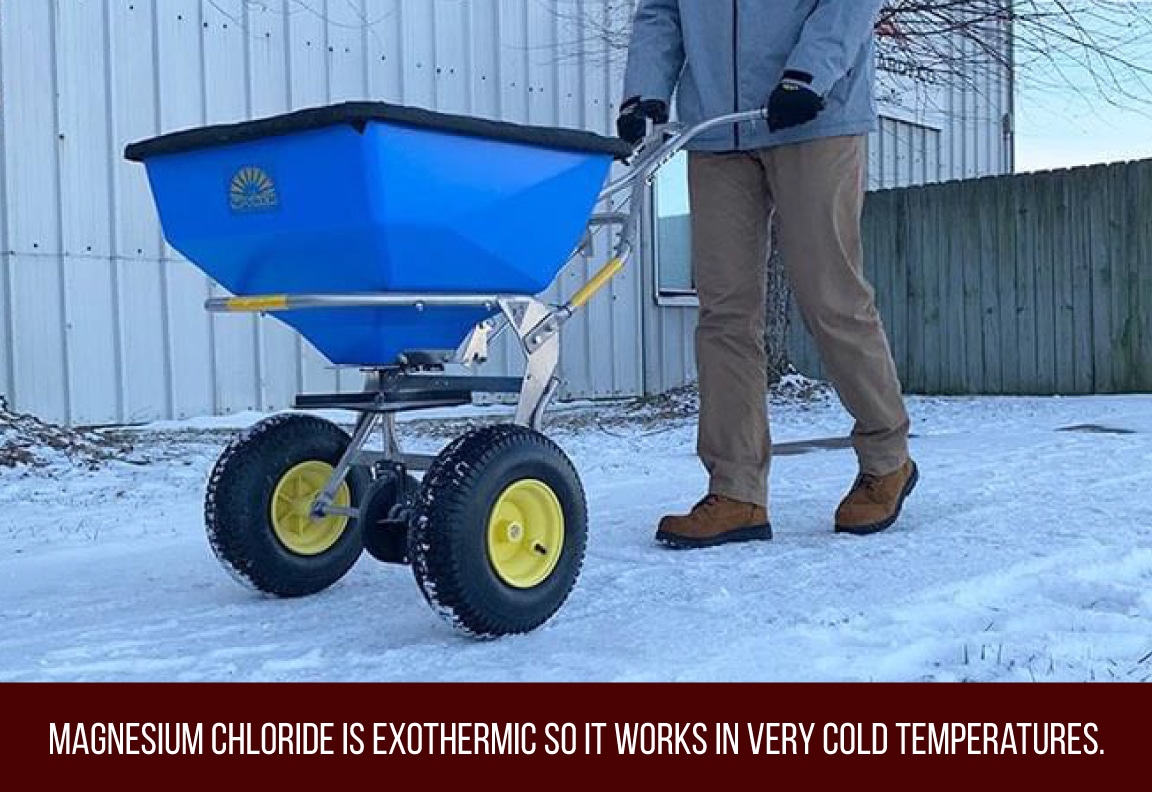
Blends
Lowest melting point: Will vary
The average cost for a 50 lb bag: Will vary a lot. Generally, $15-$30.
Blends often combine sodium chloride (in rock salt or solar salt, a purer form of rock salt used in the higher quality blends) with a more expensive ice melt such as Calcium chloride or Magnesium chloride. This way, you can create powerful combinations of attributes.
For example, if you blend sodium chloride (works for a longer time) and magnesium chloride (works fast with a low melting point), you create a fast, long-lasting ice melt with a lower effective melting point.
Another perk of blending is lowering the price of the more expensive product by stretching it out with inexpensive rock salt.
The pros and cons of blends will vary depending on the chemicals that make up the blend.
At Zimmerman Mulch, we carry all of the Trumelt ice melt blends of solar salt mixed with magnesium chloride or calcium chloride. If you need a deicing product, contact us today!
Sodium Chloride (rock salt or solar salt)
Lowest melting point: 5 degrees F
The average price for a 50 lb bag: $10.00
Sodium chloride can come in the form of rock salt or solar salt. These two types have the same chemical makeup, but they are made by different processes:
- Rock salt comes from salt mines and is not as pure as solar salt.
- Since an evaporation process makes solar salt, it is of much higher quality than rock salt.
Pros
- It's cheap. Rock salt is the most common ice melt because it is the least expensive. It's even more affordable in the brine form than in the solid state. Solar salt is, however, more costly than rock salt.
Cons
- Rock salt is hard on plants and is not environmentally friendly.
- Since Rock salt is endothermic (drawing heat from its surroundings), it is less effective in frigid temperatures.
- Rock Salt is corrosive and leaves behind a white, powdery residue.
Zimmerman Mulch carries rock salt both in bulk and in 50-lb bags.
Those are some of the most popular and widely used kinds of ice melt. We hope that this information allows you to decide which one will be best for you!
If you don't like the sound of any of the chemicals in the above list, here are two non-chemical alternatives to ice melt you could try.
Alternatives to Ice Melt - Sand or Cinders
Sand
Sand does not melt ice. However, sand is an abrasive material, and sprinkling sand on top of the ice will help give better traction.
One advantage is that sand will effectively create traction at any temperature, no matter how low. Also, sand is non-chemical and 100% environmentally friendly.
However, it will not melt the ice. And when the ice eventually melts, sand will be all over the road or sidewalk.
Sometimes people mix salt and sand, especially for use on roads. With this combination, you have both immediate traction and actual ice-melting power.
Cinders
Cinders are also combined with or as an alternative to salty ice melts. They provide traction, just like sand.
However, unlike sand, cinders can help to melt the ice faster. Cinders are dark colors, so when the sun comes out, they heat up, speeding up the melting process.
Cinders are often mixed with salt to control snow and ice on the road. Like sand, they will require clean-up after the ice melts.
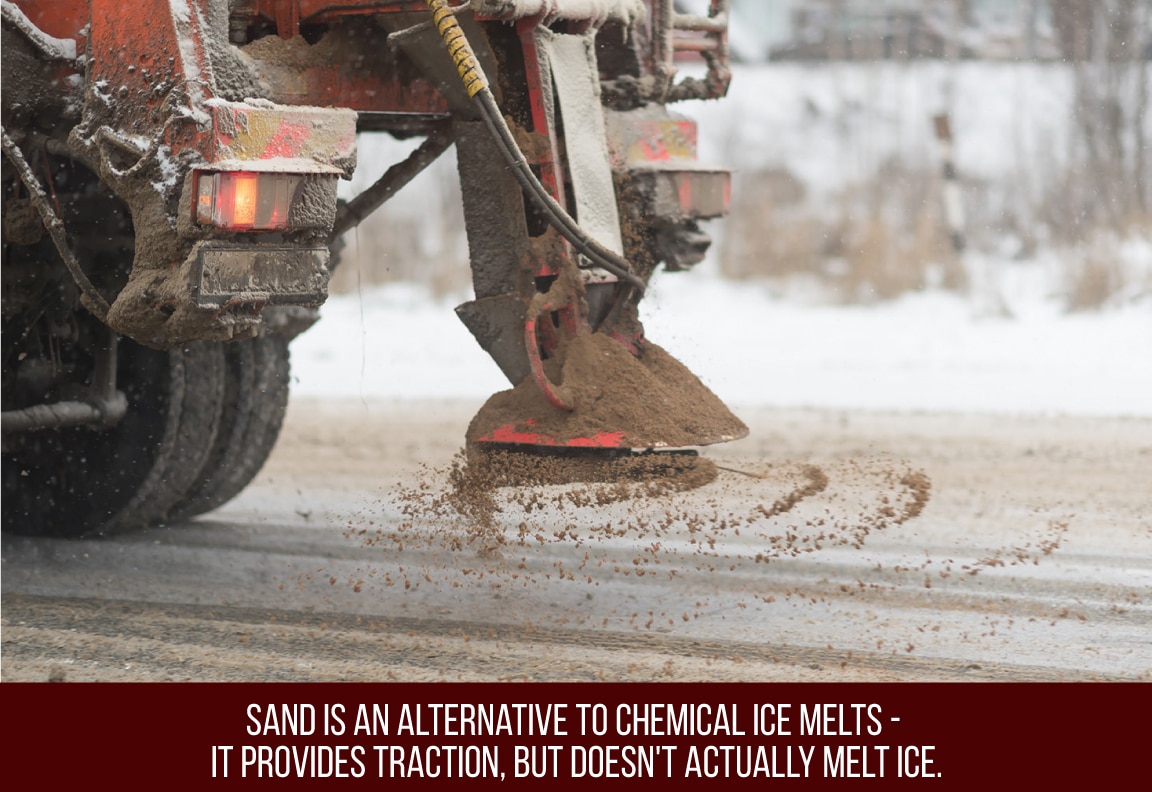
conclusion
We hope you have learned more about the science behind ice melting and the different types of de-icing products available.
With this knowledge, we hope you feel more prepared to keep your family, employees, guests, and pets safe this winter.
At Zimmerman Mulch, we know how frustrating winter can be. We've experienced it firsthand!
We are passionate about helping you face winter with confidence and peace of mind. The ice melt products that we offer are one way that we can do this.
It's easy to work with us. Simply:
- Choose the ice melt that best fits your surface, needs, and budget.
- Purchase your product and pick it up at our store.
- Apply the products to your walkway, driveway, patio, or other outdoor surfaces.
- Experience peace of mind knowing that your surfaces are ice-free and safe.
Don't let winter take you down - take it on with confidence!
We look forward to hearing from you!
